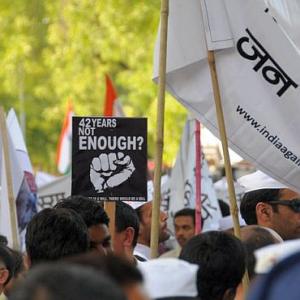 Formulating changes in any law having wide-ranging social consequences is bound to be a tightrope walk for the government.
Formulating changes in any law having wide-ranging social consequences is bound to be a tightrope walk for the government. The primary endeavour of the new Mines and Minerals Development Regulation (MMDR) Bill, therefore, is to strike a balance between fair compensation and retaining viability of mining projects, says Mining Secretary S Vijay Kumar - the man at the centre of the legislative overhaul - in an interview with Sudheer Pal Singh and Jyoti Mukul. Edited excerpts:
The MMDR Bill has been the centre of debate for quite some time. With the Bill facing criticism on various proposals, including those on profit sharing, what is the government's thinking?
The first version of the draft Bill was aimed at re-orienting the MMDR Act of 1957 based on the Hoda committee report of 2007 which was formalised in the form of the National Mineral Policy (NMP) of 2008.
There were four main directions in which the changes were desired - greater emphasis on exploration, transparency in allotment of concessions, addressing environment concerns and ensuring local population sees mining not as a threat to their existence but as an opportunity for development.
Between March 2008 and July 2009, we had a series of meetings with the state governments on this. When you amend an Act, its integrity is disturbed and when this happens repeatedly, we get a patchwork. The Ministry of Law advised us to replace the Act with a new one. The old Act had 37 sections and the new draft Bill has 147 sections.
Is there going to be dilution of the 26 per cent profit-sharing provision?
There is no such thing as dilution. The Hoda committee and the NMP say mining has environmental and social consequences. Our intention is that the miner leaves the area better than what it was so that the locals are able to use it after mining.
The local population should be involved in ensuring that mining provides them with some benefits. For this we are looking at various options. There has been a substantial change in our original June 3, 2010 proposal since it went to the group of ministers (GoM).
The principle is that there must be a fair compensatory mechanism for the local population. The current Act does not provide that as today the only mechanism available is royalty. And the royalty is not going back to the district where the mining is taking place.
What we want to include is a substantial portion of the revenues from mining should flow back into the district. We want a formulation that is fair but also does not distort investor confidence because if mining does not take place, revenue will not flow.
Has there been demand during GoM meetings so far to bring the 26 per cent number down?
Different ministries have different perceptions on this. Particularly, the steel ministry, because many of its public sector undertakings (PSUs) are involved, thinks that 26 per cent would affect the bottomline of its PSUs. We are not surprised by this as these were expected reactions.BR>
With opposition from locals growing for mining projects across the country, do you think such an intervention was necessary?
Absolutely. Over the last some years our dialogue with the industry has led us to believe that today the industry accepts the need for a revenue stream going back to the mining districts to create both local infrastructure and opportunities for the local people. The question is how to do this.
Is another meeting of GoM required?
In the last meeting of GoM on December 3, all the provisions were finalised. Many issues have been highlighted including those regarding reservations, first-in-time principle, illegal mining etc.
There may be some technical requirement of legal vetting which is almost completed. Once this is done, I think we are enabled to take it straight to the Cabinet but this is a call that the chairman of the GoM has to take. So, subject to the outcome of legal vetting, I believe the draft is now ready.
There was also the proposal for providing reservation for value addition within a state which the state government favours.
Generally, everybody agrees that when people want same resource you should prefer that company which is likely to do value addition. This is because in the process of value addition employment opportunities are created for the affected area and that is what states are really looking at. Value addition, because of the underlying economic principle, is always to be encouraged.
But the mining industry and especially the iron ore exporters were opposed to the whole idea of giving preference to steel plants.
We do not say that a steel plant is the only way of value addition. The entrepreneur has to take an overall view to see which is the best site for a plant so that different costs are minimised.
States which feel that steel plants must be sighted where the iron ore is, are missing the picture. In fact, iron ore is a small portion of the cost of steel production. Our point is: Let not the state governments interfere in the economic decision of where the plant is to be sighted. It should be left to the entrepreneur.
Since mining rights are not given out on competitive bidding but through memoranda of understanding (MoUs), don't you think there is lack of transparency?
The current MMDR Act does not recognise MoUs. It recognises two principles. A first-in-time principle if the area is not notified and a beauty parade if the area is notified. The first-come-first-serve principle is transparent because it is known that an entrepreneur comes first.
The only difference is that it is not applied at the mining level. It is only applied at the prospecting level. The change we are proposing in the new Act is that if a state is aware of the value of minerals in a certain deposit, then we should auction it.
The first-come-first-serve principle will remain in areas where mineralisation and value is not known, that is, during the initial stages of reconnaissance and exploration. We plan to introduce a new Reconnaissance Permit (RP) for bigger areas called Large Area Prospecting Licence (LAPL). The fee is heavy, so only serious people will come. The time period is short and every year you have to shed one-sixth of the area.
These LAPL would be for all minerals?
They will not include bulk minerals like iron ore, bauxite, limestone, etc. This will be for those minerals which do not show on the surface and are located below 50-300 metres. This will be a sub-legislation. Currently, three minerals of iron ore, bauxite and limestone account for 90 per cent of the revenue from royalties. So, 90 per cent of the current type of mining is outside LAPL.
Auctioning is planned to be introduced for coal. Is there a plan to introduce auctioning in other minerals as well?
For all known mineral deposits where the value of mineralisation can be estimated, the Act will say that auctioning will be done. So, as per the new law, if you have firm pre-data regarding the mine, you can bid for it.
If you have good data even if it is not completely bankable you can bid for it but it will be at prospecting stage. In other cases, where there is inadequate data about the value, it is not possible to invite bids and thus you have look for other options and the natural system will come into play which is the first-come-first-serve principle.
Would this system be binding on the states?
They have no option. The legal framework is binding on states.








